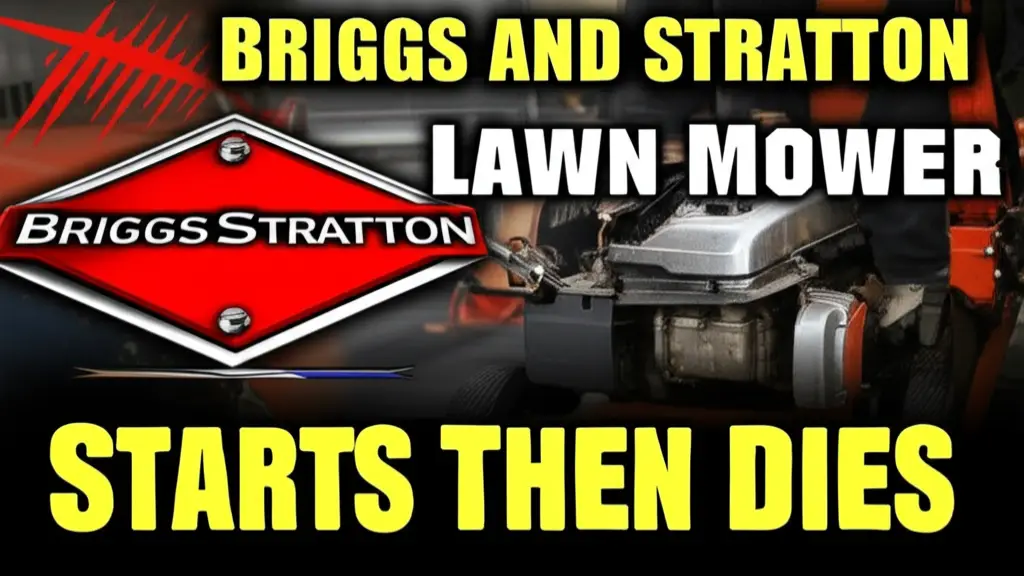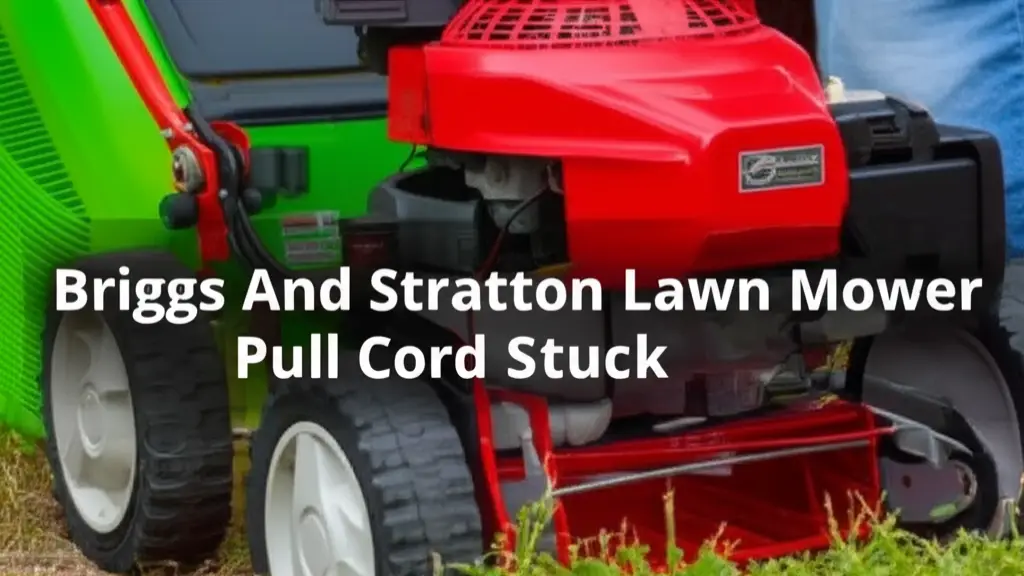· Lawn Mower Maintenance · 8 min read
Briggs And Stratton Lawn Mower Starts Then Dies

Why Your Briggs & Stratton Lawn Mower Starts Then Dies: Comprehensive Troubleshooting Guide
Is your Briggs & Stratton lawn mower starting up only to die moments later? This common issue can be frustrating, but it’s often fixable with some basic troubleshooting. From a dirty carburetor to stale gasoline, several culprits could be at play.
In this detailed guide, we’ll walk you through the most common causes, provide step-by-step solutions, and share preventive maintenance tips to keep your mower running smoothly. Let’s get started!
Takeaway
Here’s a quick summary of actionable steps to fix your Briggs & Stratton lawn mower:
- Check for old or stale gasoline and replace with fresh fuel.
- Clean or replace the air filter to ensure proper airflow.
- Inspect and clean the carburetor, focusing on jets and float height.
- Verify the spark plug is in good condition and properly gapped.
- Ensure the fuel cap vent is clear to prevent vacuum lock.
- Clean and sharpen blades to reduce engine strain.
- Check for moisture or blockages in the fuel line and clear them.
Understanding the Problem
When a Briggs & Stratton lawn mower starts but dies, the issue typically stems from disruptions in the fuel system, ignition system, or engine components. Common problems include clogged carburetors, stale fuel, faulty spark plugs, blocked fuel cap vents, dirty air filters, or debris-laden blades. Below, we explore each cause in detail, offering practical solutions to get your mower back in action.
1. Dirty Carburetor
The carburetor mixes air and fuel for combustion. Dirt, old fuel, or moisture can clog it, preventing proper fuel delivery and causing the engine to stall.
Symptoms
- Engine starts but dies within seconds.
- Rough running or stalling when engaging the blades.
- Difficulty starting or inconsistent performance.
Diagnosis
- Check if the carburetor bowl has fuel.
- Look for signs of flooding (excess fuel) or insufficient fuel flow.
- Inspect the air filter, as a dirty filter can exacerbate carburetor issues.
Fix
- Safety First: Turn off the mower and disconnect the spark plug wire.
- Locate the Carburetor: Find it near the air filter, typically under a cover.
- Drain the Fuel Bowl: Use the drain screw to empty old fuel into a safe container.
- Remove the Carburetor (Optional): For thorough cleaning, unscrew and remove it.
- Clean the Carburetor: Spray carburetor cleaner into jets and passages. Soak if heavily clogged.
- Check the Float: Ensure the float moves freely and the needle valve seats properly. Adjust float height per the manual if needed.
- Reassemble: Secure all gaskets and screws, then test the mower.
Advanced Tip: Adjusting the float height requires precision. Refer to Briggs & Stratton’s for detailed instructions.
2. Old or Stale Gasoline
Gasoline degrades within 30 days, forming varnish that clogs the fuel system, leading to starting issues or engine stalling.
Symptoms
- Engine starts but dies quickly.
- Hard starting after long storage periods.
- Poor performance or stalling during use.
Diagnosis
- Check the fuel’s age and appearance (cloudy or dark fuel indicates staleness).
- Inspect the fuel tank and lines for varnish or sludge.
Fix
- Drain Old Fuel: Use a siphon pump to empty the tank.
- Inspect Fuel Filter: Replace if clogged.
- Refill with Fresh Fuel: Use 87-octane unleaded gasoline.
- Add Fuel Stabilizer: Use a stabilizer for storage to prevent degradation.
Tip: Use fuel within 1-2 months and dispose of old gas at a recycling center. Learn more about fuel-related issues at Lawn Mower Fuel Problems.
3. Faulty Spark Plug
A worn, dirty, or improperly gapped spark plug can cause weak sparking, leading to engine failure shortly after starting.
Symptoms
- Engine starts but dies immediately.
- No spark when pulling the starter cord.
- Misfiring or uneven running.
Diagnosis
- Remove the spark plug and check for wear, dirt, or carbon deposits.
- Test the spark by grounding the plug and pulling the starter cord.
- Verify the gap with a feeler gauge.
Fix
- Remove Spark Plug: Use a spark plug wrench.
- Clean or Replace: Clean with a wire brush or replace if damaged.
- Check Gap: Adjust to the manufacturer’s specification (typically 0.030 inches).
- Reinstall and Test: Secure the plug and start the mower.
Tip: Replace the spark plug annually. For more on spark plug maintenance, visit Servicing the Spark Plug.
4. Blocked Fuel Cap Vent
The fuel cap vent allows air into the tank as fuel is used. A blockage creates a vacuum, stopping fuel flow and causing the engine to die.
Symptoms
- Engine starts but stalls quickly.
- Pressurized tank when removing the cap.
- Inconsistent performance.
Diagnosis
- Remove the cap and inspect the vent hole for debris.
- Check the gasket for damage.
Fix
- Remove Fuel Cap: Take it off carefully.
- Clear Vent Hole: Use a pin or compressed air to unblock it.
- Inspect Gasket: Replace if damaged.
- Test Mower: Reattach the cap and start the engine.
5. Dirty Air Filter
A clogged air filter restricts airflow, starving the engine and causing it to stall.
Symptoms
- Engine dies shortly after starting.
- Reduced power or poor performance.
- Excessive fuel consumption.
Diagnosis
- Remove the air filter and check for dirt or debris.
- Hold it to light; if no light passes through, it’s clogged.
Fix
Locate Air Filter: Usually under a cover near the carburetor.
Remove and Inspect: Check for clogs or damage.
Clean or Replace:
- Foam filters: Wash with soap and water, dry thoroughly.
- Paper filters: Replace if clogged.
Reinstall and Test: Secure the filter and start the mower.
Tip: Replace the air filter every season or 300 hours of use, more often in dusty conditions.
6. Clogged Blades
Grass and debris on blades increase engine strain, potentially causing it to stall.
Symptoms
- Engine dies when blades are engaged.
- Uneven cutting or excessive vibration.
- Reduced mowing efficiency.
Diagnosis
- Inspect blades for grass, dirt, or damage.
- Check for dullness or imbalance.
Fix
- Safety First: Disconnect the spark plug wire.
- Remove Blades: Use a wrench to loosen blade bolts.
- Clean Blades: Scrape off grass and dirt with a brush.
- Sharpen Blades: Use a file or take to a professional.
- Reinstall and Test: Ensure blades are balanced before testing.
7. Moisture or Blockage in Fuel Line
Water or debris in the fuel line disrupts fuel flow, causing the engine to stall.
Symptoms
- Engine starts but dies quickly.
- Intermittent starting issues.
- Clogged or discolored fuel filter.
Diagnosis
- Inspect the fuel line for cracks, leaks, or moisture.
- Check the fuel filter for blockages.
Fix
- Inspect Fuel Line: Look for damage or debris.
- Replace Fuel Filter: Install a new one if clogged.
- Clear Fuel Line: Use compressed air or a brush to clean.
- Replace if Damaged: Install a new fuel line if necessary.
- Refill Tank: Use fresh fuel and test the mower.
8. Ignition System Issues
Faulty ignition components, like the coil or kill switch, can cause the engine to die after starting.
Symptoms
- No spark or weak spark.
- Engine dies when throttle is adjusted.
- Intermittent stalling.
Diagnosis
- Test the spark plug for spark.
- Inspect the ignition coil and wiring for damage.
Fix
- Test Spark: Ground the spark plug and pull the starter cord to check for spark.
- Inspect Coil: Replace if no spark is detected.
- Check Kill Switch: Ensure it’s functioning properly.
- Consult a Professional: For complex ignition issues, visit a Briggs & Stratton Dealer.
9. Compression Problems
Low compression due to improper valve clearance or leaks can prevent the engine from running consistently.
Symptoms
- Hard starting or immediate stalling.
- Weak engine performance.
- Unusual engine noises.
Diagnosis
- Perform a cylinder leak-down test to check compression.
- Inspect valve clearance per the manual.
Fix
- Adjust Valves: Use a feeler gauge to set proper clearance.
- Professional Help: For compression issues, consult a technician, as specialized tools are needed.
10. When to Replace Your Mower
If your mower is over 5-8 years old, requires frequent repairs, or shows signs of rust or wear, consider replacing it. Newer models offer improved efficiency and safety features. For guidance on choosing a new mower, check Best Electric Lawn Mower.
Preventive Maintenance Tips
To avoid future issues:
- Run Tank Dry Before Storage: Prevent fuel degradation.
- Use Fuel Stabilizer: Extend fuel life during off-seasons.
- Annual Maintenance: Replace spark plugs and air filters yearly.
- Store Properly: Keep the mower in a dry, covered area.
- Regular Cleaning: Clear debris from blades and undercarriage.
FAQ
Why does my lawn mower only run for a few seconds then dies?
A dirty carburetor, stale fuel, or faulty spark plug is often the cause. Check these components and follow the fixes outlined above.Why does my lawn mower start and then cut off?
A blocked fuel cap vent, dirty air filter, or clogged blades could be to blame. Ensure these are clean and functional.Why does my lawn mower turn off as soon as I turn it on?
Moisture in the fuel line, a weak spark plug, or low fuel flow may be the issue. Inspect the fuel and ignition systems.Why does my Briggs & Stratton run for a while then die?
A stuck float or clogged carburetor jets could cause this. Cleaning or rebuilding the carburetor may help.Why won’t my lawn mower stay running after starting?
Check for a dirty carburetor, old fuel, or a faulty spark plug. Follow the troubleshooting steps provided.How do you clean a lawn mower carburetor without removing it?
Use a carburetor cleaner spray to clear jets while attached, but removing it for thorough cleaning is best. Always follow safety precautions.What if my mower emits smoke when starting?
White or blue smoke may indicate burning oil, while black smoke suggests a dirty air filter or bad fuel. Check oil levels and clean the filter. Learn more at White Smoke from Mower.
Final Words
Fixing a Briggs & Stratton lawn mower that starts then dies is often a matter of addressing simple issues like stale fuel, a dirty carburetor, or a clogged air filter. By following the steps in this guide, you can diagnose and resolve most problems yourself. Regular maintenance, such as using fresh fuel and replacing filters, will keep your mower in top shape. If issues persist, consult a professional at a Briggs & Stratton Service Dealer or consider upgrading to a new model for better performance.


